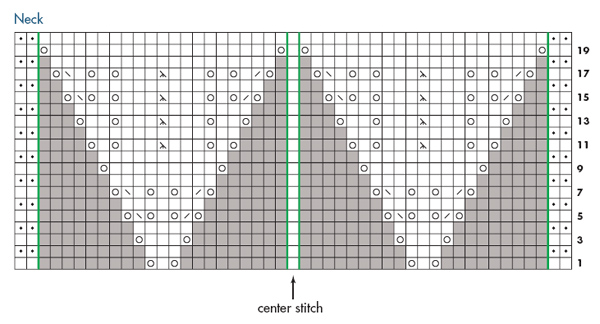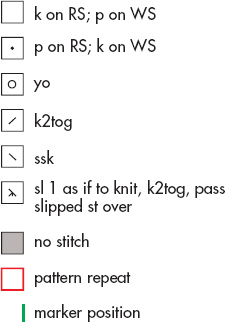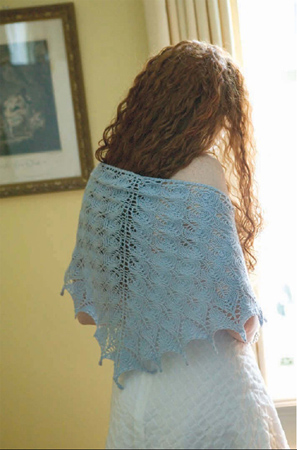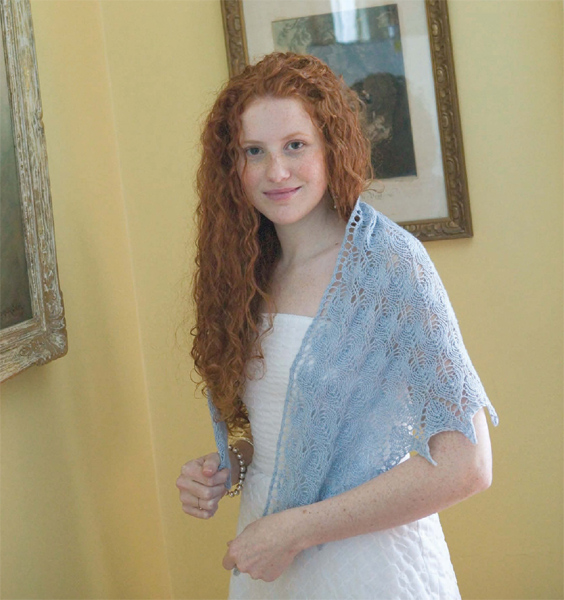
In this triangular shawl, Evelyn A. Clark proves that the simple beauty of traditional Shetland lace patterns never goes out of style. Evelyn works the triangle from the top down (that is, from the wide edge to the point) in the classic fir cone lace pattern. The intricate undulating pattern is surprisingly simple to knit. She finishes off the triangle with a simple horizontal edging, then blocks the decorative scallops along the edges into sharp points. Because the edging can be started at the end of any 10-row lace repeat, you can easily work a larger shawl by adding another pattern repeat (but remember to purchase more yarn).
54" (137 cm) wide across top edge and 24" (61 cm) long from center of top edge to bottom of point, after blocking.
About 548 yd (501 m) of fingering-weight (Super Fine #1) yarn.
We used: Jaeger Cashmina (80% cashmere, 20% merino; 137 yd [125 m]/25 g): #043 sky, 4 balls.
Size 6 (4 mm): 24" (60-cm) circular (cir). Adjust needle size if necessary to obtain the correct gauge.
Size G/6 (4 mm) crochet hook; 1 yd (1 meter) contrasting waste yarn; markers (m); rust-proof pins for blocking.
22 sts and 28 rows = 4" (10 cm) in St st, before blocking.
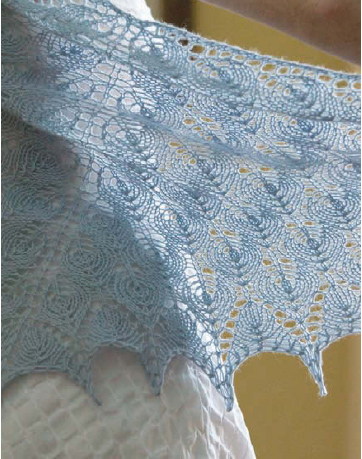
With crochet hook and waste yarn, ch 4 (see Glossary, page 148). With main yarn, pick up and knit 2 sts in the bumps on the back side of the center 2 chain sts—2 sts. Knit 6 rows.
Next row: K2, rotate piece 90 degrees clockwise, pick up and knit 1 st in each of the 3 garter ridges along selvedge of piece, rotate piece 90 degrees clockwise again, unzip waste yarn chain to expose 2 sts at base of piece, place these 2 sts onto left needle and knit them—7 sts total. Work Rows 1–20 of Neck chart (see page 46)—47 sts when Row 20 has been completed. Change to Body chart for the main fir cone patt. Rep Rows 1–10 of Body chart 8 times total—207 sts; 100 lace rows total: 20 rows Neck chart, 80 rows Body chart. Change to Edging chart and work Rows 1–14 once—223 sts.
Next row: K2, slip marker (sl m), yo, k9, yo, [k1, yo, k9, yo] 10 times, sl m, k1 (center st), sl m, [yo, k9, yo, k1] 10 times, yo, k9, yo, sl m, k2—267 sts. BO all sts very loosely.
Use rust-proof pins or blocking wires to shape the sharp points along the edges.
Weave in loose ends leaving tails 2–3" (5–7.5 cm) long; tails will be trimmed flush with the surface of the shawl after blocking.
Blocking: Soak shawl for at least 20 minutes. Wrap in a towel to remove excess water. Lay flat and smooth into shape. If using blocking wires, run wires through eyelets along top edge and pin in place. Pull out points along side edges at each “yo, k1, yo” in last row of edging and pin to desired finished measurements. Leave in place until thoroughly dry. Trim yarn ends.
